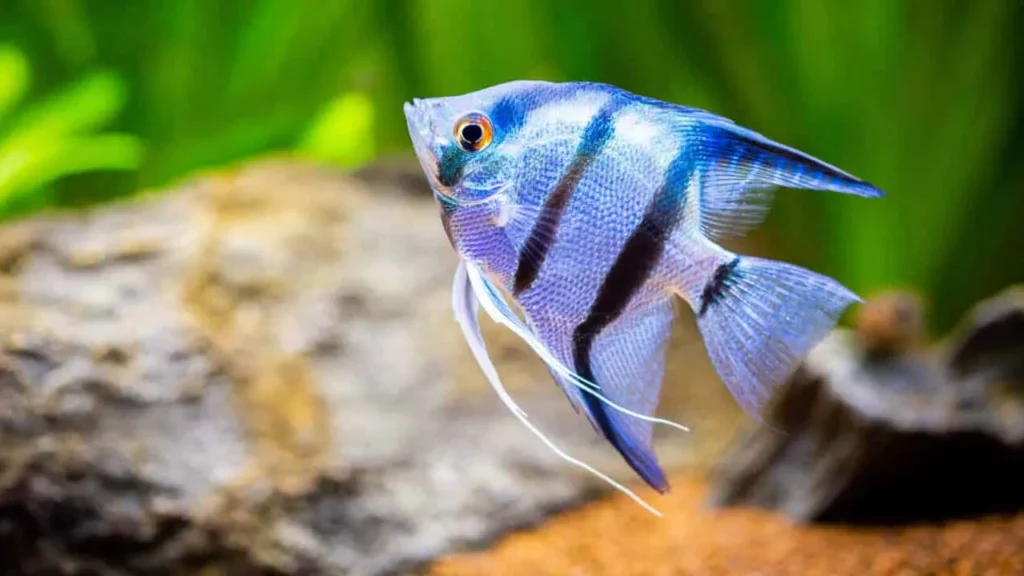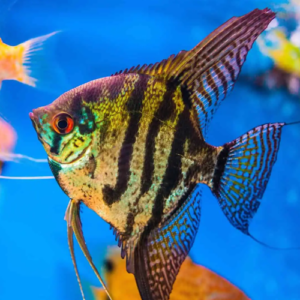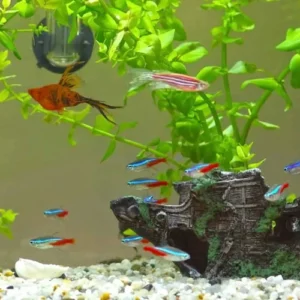Angelfish Breeding Guide: The Most Important Steps
Setting up the perfect Angelfish breeding environment requires attention to aquarium size, water parameters like pH, temperature, and hardness, as well as considerations for filtration, aeration, and appropriate decorations. Nutrition plays a pivotal role, with a balanced diet being crucial for breeding readiness. When selecting breeding pairs, age, physical attributes, and specific behaviors are key indicators of compatibility and health. The breeding process itself is a dance of courtship behaviors, spawning, fertilization, and meticulous care of the eggs. Once hatched, the fry undergo various growth stages, transitioning from yolk sac nourishment to adult food. Throughout this process, maintaining optimal water conditions and providing a balanced diet ensures the health and vitality of these aquatic wonders.
Home » Guides » Fish Care » Angelfish » Angelfish Breeding Guide: The Most Important Steps
Angelfish Fact Sheet
| Scientific Name | Pterophyllum |
| Common Name | Angelfish |
| Care Difficulty | Easy |
| Minimum Tank Size | 20 Gallons (90 Liters) |
| Life Expectancy | 10 Years |
| Average Size | 6 Inch (15cm) |
| Temperature | 73-84°F (22-29°C) |
| Diet | Omnivore |
| Behavior | Friendly/Peaceful |
| Breeding | Easy/Medium |
| pH | 6-7 |
| dGH | 1-10 (0-180PPM) |
| Live Plant Friendly | Yes |
Understanding Angelfish
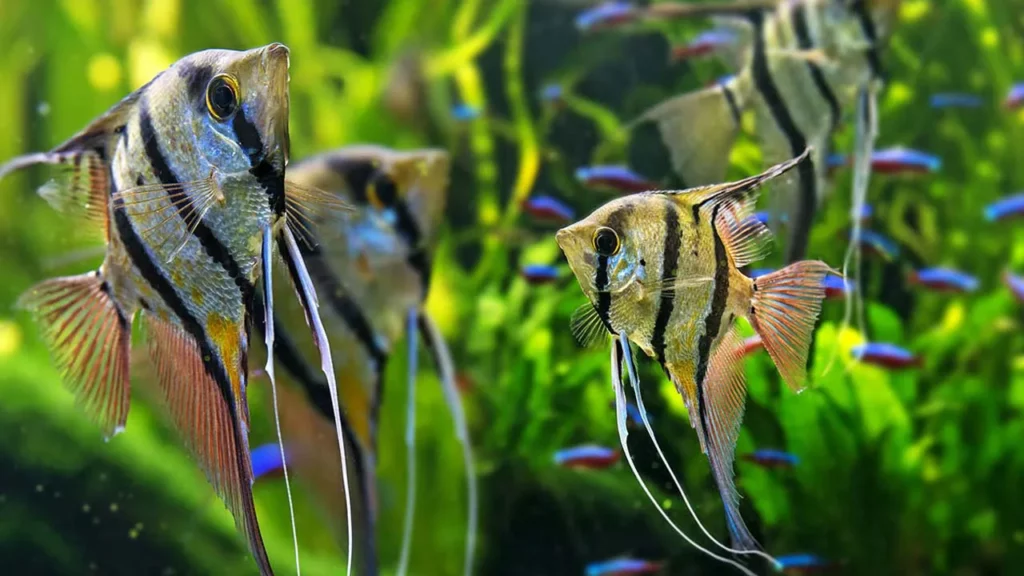
Origin and natural habitat
The Amazon Basin, spanning across multiple South American countries, is a vast network of rivers, streams, and flooded forests. This intricate water system, teeming with life, is the cradle of the Angelfish. The Pterophyllum, as they’re scientifically known, have evolved in these soft, slightly acidic waters, surrounded by dense vegetation and a myriad of other aquatic species.
The natural habitat of the Angelfish is quite fascinating. They’re often found in slow-moving or still waters, where the dense canopy of rainforest trees filters the sunlight, creating a dimly lit aquatic environment. This subdued lighting, combined with the tannins released by decaying organic matter, gives the water a tea-colored hue. It’s in these serene, shadowy waters that the Angelfish gracefully swim, navigating through submerged roots, fallen branches, and aquatic plants.
The flooded forests of the Amazon provide a unique environment for the Angelfish. During the rainy season, vast areas of the forest floor get submerged, creating a labyrinth of aquatic pathways. The Angelfish, being opportunistic, explore these new territories, feeding on small invertebrates and even some terrestrial insects that find themselves trapped in this watery maze.
It’s essential to understand this natural setting because it gives us insights into the conditions Angelfish thrive in. By replicating aspects of their native habitat in our aquariums, we can ensure they live healthy, stress-free lives.
Physical characteristics
When you first lay eyes on an Angelfish, it’s hard not to be captivated by their unique shape and mesmerizing patterns. Their tall, flattened bodies are like living canvases, painted with a variety of colors and designs that can leave any observer spellbound.
Starting with their shape, Angelfish have a distinct triangular or arrowhead silhouette. This vertically elongated body allows them to navigate with ease through dense vegetation and tight spaces in their natural habitat. Their dorsal and anal fins stretch out long and tapering, often reaching the base of their caudal fin. This gives them an almost ethereal appearance, as if they’re wearing flowing gowns while they glide through the water.
Their coloration is where things get even more interesting. While wild Angelfish predominantly showcase silver bodies adorned with three vertical black stripes, the world of aquarium breeding has introduced a plethora of color variations. From golds to blacks, marbles to blues, and even koi-patterned Angelfish, the spectrum is vast and continually expanding. Some of these captive-bred varieties have even lost their stripes, while others might flaunt a shimmering pearlescent sheen.
But it’s not just about beauty. Those keen eyes of theirs are always on the lookout. Positioned on either side of their head, they provide a wide field of vision, essential for both hunting tiny prey and evading potential threats. Just below their eyes, their mouths are slightly downturned, perfect for picking off food items from surfaces.
Their pectoral fins, delicate and almost transparent, flutter rapidly, helping them hover in place or make swift directional changes. Meanwhile, their ventral fins, which dangle like long threads, play a role in stability and also act as tactile organs, sensing the environment around them.
In terms of size, while they might start as tiny, almost transparent fry, Angelfish can grow quite impressive in a home aquarium. A mature Angelfish can reach up to 6 inches in length, with their height (from the top of the dorsal fin to the bottom of the anal fin) being even more impressive, sometimes reaching up to 8 inches.
Behavior and temperament
Dive a little deeper into the world of Angelfish, and you’ll find that their behavior and temperament are as intriguing as their appearance. These fish are not just pretty faces; they have personalities that can be both endearing and, at times, surprising.
In their natural habitat, Angelfish are often seen in small groups or pairs, gracefully patrolling their territory. They are naturally curious creatures, often seen investigating nooks and crannies or following the trail of a potential meal. This curiosity translates well into the aquarium setting, where they might often be the first to greet you, hoping for a tasty morsel or just being their inquisitive selves.
However, it’s essential to note that Angelfish, despite their heavenly name, can have a bit of a devilish side, especially when it comes to their territory. As they mature, they can become quite territorial, especially during breeding times. It’s not uncommon for them to chase away other fish that venture too close to their chosen nesting site. This assertiveness is a stark contrast to their usual calm demeanor, reminding us that even angels have their moments.
Social dynamics among Angelfish can be fascinating to observe. While they can coexist peacefully with many other species, their interactions with their kind can range from harmonious to hierarchical. It’s not uncommon to see a pecking order established in a group, with dominant individuals asserting their status. However, this isn’t always the case, and many Angelfish live harmoniously in well-balanced community tanks.
When it comes to their swimming patterns, Angelfish have a certain elegance about them. Their long fins trail behind them as they move with a slow, deliberate grace. However, when they spot food or sense danger, they can be surprisingly swift, darting away or towards their target with unexpected speed.
One more thing to note is their intelligence. Angelfish are among the more intelligent freshwater fish species. Over time, they can recognize their caregivers, often swimming to the front of the tank in anticipation during feeding times or when they sense familiar movements outside their aquatic domain.
Aquarium Setup for Breeding
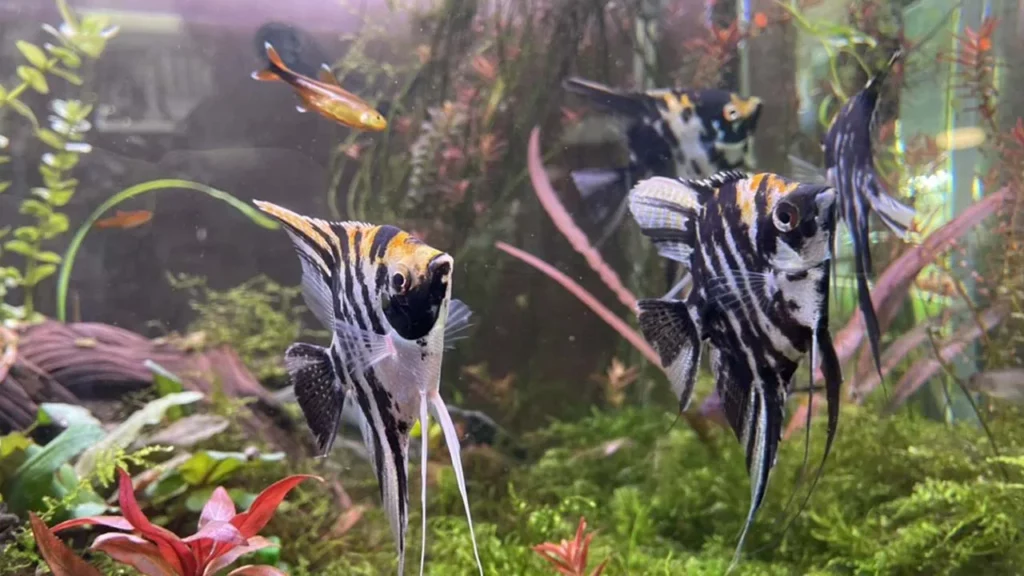
Size and dimensions
Angelfish, with their tall and broad fins, require an aquarium that accommodates their unique shape. A standard rectangular tank might suffice for juveniles, but as they grow and especially if breeding is on the agenda, a taller tank becomes essential. This ensures they can swim freely without their long fins touching the substrate or getting too close to the surface.
For a pair of breeding Angelfish, a 20-gallon tank is the absolute minimum. However, I’d always recommend going larger if possible. A 40-gallon breeder tank, with its increased width and height, is ideal. It provides ample space for the fish to establish territories, select prime breeding spots, and reduces stress, which is crucial for successful breeding.
If you’re considering keeping a community of Angelfish or introducing other species into the mix, then even larger tanks, like 55 gallons or more, would be more appropriate. This ensures each Angelfish has its territory, reducing the chances of aggressive confrontations, especially during breeding times.
The dimensions of the tank play a role too. A tank that’s too long but not tall enough might not be ideal for Angelfish. Their natural habitat consists of tall, submerged vegetation and tree roots, so a taller tank mimics this environment better. A good rule of thumb is to ensure the tank’s height is at least 18 inches, though more is always better.
Lastly, while we’re on the topic of size, let’s not forget about the space around the aquarium. Ensure there’s enough room around the tank for maintenance activities, and if you’re planning on adding external filters or other equipment, you’ll need space for those as well.
Water parameters
pH Level
Water, the very essence of life in an aquarium, is more than just H2O. Its properties, especially the pH level, play a pivotal role in the health and well-being of our aquatic friends. For Angelfish, the pH level is particularly crucial, especially when we’re setting the stage for breeding.
In their natural habitat within the Amazon Basin, Angelfish are accustomed to waters that are slightly acidic. This is due to the organic matter, like leaves and wood, that decays in the water, releasing tannins that naturally lower the pH.
For Angelfish, a pH range of 6.0 to 7.5 is considered ideal. However, for breeding purposes, a slightly more acidic environment, around 6.5 to 6.8, can increase the chances of successful fertilization and hatching. It’s believed that this slightly acidic water can help in activating the sperm and ensuring the eggs remain fungus-free.
Now, how do you achieve and maintain this pH level in your aquarium? There are natural ways to slightly acidify your tank water. Adding driftwood or Indian almond leaves can release tannins, which not only give the water a soft amber tint reminiscent of their natural habitat but also gently lower the pH. Peat moss, when added to filters, can have a similar effect.
However, it’s essential to approach pH adjustments with caution. Rapid changes can stress fish, leading to health issues. Always make changes gradually and monitor the pH regularly using a reliable test kit. If you’re using commercial pH adjusters, follow the instructions meticulously and always aim for stability over hitting an exact number.
Remember, while the pH is a crucial parameter, consistency is key. Angelfish, like many other species, can adapt to a range of conditions as long as they remain stable. So, as you play the role of nature’s chemist, always prioritize the well-being of your finned friends, ensuring their waters remain as harmonious as their serene beauty.
Temperature
In the vast stretches of the Amazon, water temperatures remain relatively consistent, typically ranging between 76°F to 84°F (24°C to 29°C). This warm, tropical environment is what Angelfish have evolved in, and it’s what they thrive in.
For general keeping in an aquarium, maintaining a temperature between 76°F to 82°F (24°C to 28°C) is ideal for Angelfish. However, when you’re looking to encourage breeding, a slight increase towards the upper end of this range, around 80°F to 82°F (27°C to 28°C), can be beneficial. This gentle warmth can stimulate breeding behaviors, mimicking the onset of the rainy season in their natural habitat, a time when many fish species spawn.
To maintain consistent temperatures, a reliable aquarium heater is essential. But don’t just rely on the heater’s thermostat. Always have a separate aquarium thermometer to monitor the actual water temperature. This double-check ensures that the heater is functioning correctly and that your Angelfish are in their comfort zone.
It’s also worth noting that sudden temperature fluctuations can be stressful for fish. If you need to adjust the temperature, do so gradually, over several hours or even days. This slow change allows fish to acclimate without undue stress.
Lastly, while we’re focusing on warmth, let’s not forget about cooling. In some climates or during particularly hot seasons, aquarium temperatures can rise above the safe range. In such cases, reducing the aquarium lighting, placing fans near the surface, or even using specialized aquarium chillers can help keep things cool.
Hardness
Water hardness, often overlooked, is like the backbone of an aquarium’s water chemistry. It refers to the concentration of dissolved minerals, primarily calcium and magnesium, in the water. For our elegant Angelfish, understanding and managing water hardness can be the key to their well-being and breeding success.
In the Amazon Basin, where Angelfish hail from, the waters are typically soft due to the lack of dissolved minerals. This softness is a result of the rainforest’s heavy rainfall, which dilutes mineral concentrations, and the presence of decaying organic matter, which can bind and remove minerals from the water.
For Angelfish, a general hardness (GH) of 3 to 8 dGH (degrees of general hardness) and a carbonate hardness (KH) of 2 to 5 dKH is considered ideal. When it comes to breeding, softer water, leaning towards the lower end of this range, can be beneficial. Soft water can enhance the health of the Angelfish, improve egg viability, and increase the chances of successful fertilization.
So, how can you achieve and maintain the desired hardness levels in your aquarium?
- Starting Right: If you’re fortunate enough to have naturally soft tap water, you’re already ahead of the game. However, it’s always a good idea to test your tap water’s hardness using a reliable test kit to know where you stand.
- Reverse Osmosis (RO) Water: If your tap water is too hard, consider using RO water. Reverse osmosis systems filter out the majority of dissolved minerals, resulting in soft water. You can mix RO water with tap water to achieve the desired hardness level.
- Natural Methods: Adding driftwood or peat moss to your aquarium can help soften the water slightly. These materials release tannins, which bind to minerals, reducing overall hardness.
- Commercial Products: There are water conditioners and specialized salts available that can adjust water hardness. However, use these with caution and always follow the manufacturer’s instructions.
- Regular Monitoring: As with pH and temperature, consistency is crucial. Regularly test the water hardness to ensure it remains within the desired range.
Filtration and aeration
Imagine the heart and lungs of your aquarium, tirelessly working to keep the environment clean and oxygen-rich. That’s your filtration and aeration system. For our majestic Angelfish, ensuring efficient filtration and proper aeration is paramount, especially when breeding is in the cards.
Filtration: The primary role of a filter is to remove physical debris, break down harmful chemicals, and house beneficial bacteria that convert toxic waste products into less harmful substances.
- Mechanical Filtration: This involves physically trapping particles and debris. Sponge filters, foam pads, and filter floss are common mechanical filtration media. For Angelfish, a filter that can effectively remove debris without creating a strong current is ideal, given their preference for calm waters.
- Biological Filtration: Beneficial bacteria colonize surfaces in the aquarium, including filter media. These bacteria convert harmful ammonia, produced from fish waste, into nitrite and then into the less harmful nitrate. Ceramic rings, bio-balls, and sponges are popular choices for biological filtration.
- Chemical Filtration: This involves removing or altering dissolved substances in the water. Activated carbon is a common chemical filter media, which can remove odors, discoloration, and some organic compounds. However, during breeding, it’s essential to ensure that any chemical filtration doesn’t remove essential minerals or medications.
Aeration: While Angelfish don’t require rapid water movement, they do need well-oxygenated water, especially during breeding.
- Air Pumps and Stones: An air pump connected to an air stone or diffuser can introduce tiny bubbles into the tank, increasing the water’s oxygen content. While the bubbles themselves don’t add much oxygen, the movement they create at the surface facilitates gas exchange, ensuring a steady supply of oxygen.
- Filter Outflow: The outflow from many filters can also promote aeration. Adjusting the filter’s outflow to create gentle ripples on the water’s surface can enhance gas exchange without creating strong currents.
- Plants: Live aquatic plants produce oxygen during photosynthesis. While they also consume oxygen at night, a well-planted tank can contribute to the overall oxygen levels, especially during daylight hours.
Substrate and decorations
Plants
For Angelfish, plants are more than just decorative elements; they’re reminiscent of their natural habitat, providing shelter, comfort, and even breeding sites.
Benefits of Plants for Angelfish:
- Shelter and Security: Plants offer hiding spots, reducing stress and making Angelfish feel secure. This is especially crucial during breeding, as plants can provide secluded spots for laying eggs.
- Natural Filtration: Plants absorb nitrates, ammonia, and other waste products, helping to maintain water quality.
- Oxygen Production: Through photosynthesis, plants release oxygen, contributing to the overall oxygenation of the tank.
Ideal Plants for Angelfish:
- Amazon Sword (Echinodorus spp.): With its broad leaves and tall stature, the Amazon Sword is a favorite among Angelfish enthusiasts. Its leaves often serve as a site for laying eggs.
- Java Fern (Microsorum pteropus): This hardy plant can be attached to driftwood or rocks. Its undulating leaves create a beautiful backdrop and offer shelter.
- Anubias: Another plant that can be anchored to hardscape, Anubias has thick, leathery leaves that are resistant to nibbling, should your Angelfish get curious.
- Vallisneria: This tall, grass-like plant can create dense forests in the background, mimicking the flooded jungles of the Amazon.
- Water Sprite (Ceratopteris thalictroides): A fast-growing plant, Water Sprite can be planted in the substrate or left floating. Its fine leaves are excellent for fry to hide in.
Planting Tips:
- Spacing: Ensure plants are spaced out, allowing Angelfish to navigate between them easily. Remember, while dense planting can look beautiful, Angelfish need room to swim.
- Substrate: A nutrient-rich substrate can promote plant growth. Consider substrates designed for planted tanks.
- Lighting: Ensure you have adequate lighting for the plants you choose. While Angelfish prefer subdued lighting, many plants require moderate to high light levels to thrive.
- Maintenance: Regularly trim and prune plants to maintain the desired look and ensure they don’t overtake the tank.
Caves and Hiding Spots
Beyond the verdant embrace of aquatic plants, the underwater landscape can be further enhanced and made functional with caves and hiding spots. For Angelfish, these structures are not just ornamental; they offer sanctuary, territorial markers, and sometimes even a canvas for their reproductive endeavors.
Why Caves and Hiding Spots?
- Safety and Security: Just like in their natural habitat, where submerged roots and overhangs provide shelter, caves and hiding spots in an aquarium offer Angelfish a place to retreat to when they feel threatened or stressed.
- Territorial Markers: Especially during breeding times, Angelfish can become territorial. Having distinct landmarks like caves can help them establish and defend their territories.
- Breeding Sites: While Angelfish often prefer broad-leaved plants for laying eggs, some might choose the smooth inner surfaces of caves or the sides of ceramic decorations.
Ideal Caves and Hiding Spots for Angelfish:
- Driftwood: Natural driftwood not only adds a rustic charm to the aquarium but also provides nooks and crannies for Angelfish to explore and hide.
- Ceramic Caves: Available in various shapes and sizes, these can be strategically placed in the aquarium. Their smooth inner surfaces can sometimes become egg-laying sites.
- Rock Formations: Stacking rocks (ensure they’re aquarium-safe) can create natural-looking caves and overhangs. Ensure they’re securely placed to prevent toppling.
- PVC Pipes: While not the most natural-looking, PVC pipes can be buried or camouflaged within the substrate, providing a simple and effective hiding spot.
- Commercially Available Decor: Many aquarium shops offer decorative items designed to provide hiding spots, from faux rock caves to themed decorations.
Setting Up Tips:
- Stability: Ensure that any structure, especially rock formations, is stable. The last thing you want is a cave-in that could harm your fish or damage the tank.
- Size: Ensure the openings of caves and hiding spots are large enough for Angelfish to enter and exit without getting stuck, but also snug enough to offer a sense of security.
- Placement: Position caves and hiding spots in various areas of the tank, from corners to mid-ground, giving Angelfish multiple options.
- Camouflage: If using artificial items like PVC pipes, consider burying them in the substrate or covering them with plants to maintain a natural look.
Diet and Nutrition
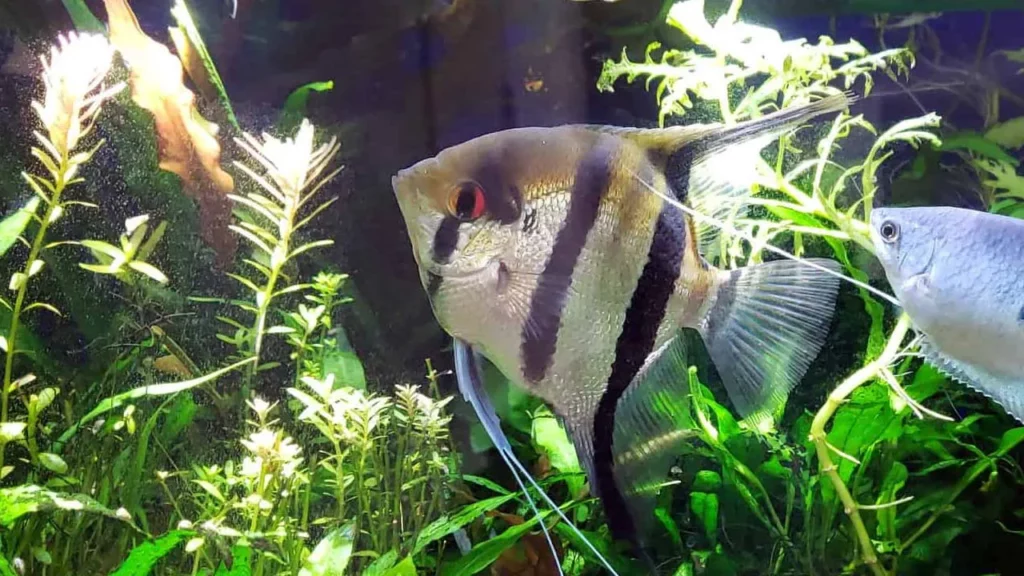
Importance of a balanced diet
Food, glorious food! It’s not just a source of sustenance; it’s the very fuel that powers the vibrant dance of life in our aquarium. For Angelfish, a balanced diet isn’t just about filling their bellies; it’s about nourishing their very essence, ensuring vibrant colors, robust health, and optimal breeding conditions.
Angelfish require a mix of nutrients to truly flourish. Here’s why a balanced diet is paramount:
- Health and Immunity: A varied diet ensures Angelfish receive all essential nutrients, from proteins and fats to vitamins and minerals. This boosts their immune system, making them less susceptible to diseases.
- Color Vibrancy: The right nutrients can enhance the natural colors of Angelfish, making them even more visually stunning. Some foods even contain color-enhancing compounds, ensuring your fish remain as radiant as nature intended.
- Growth: Especially for juvenile Angelfish, a balanced diet is crucial for proper growth. The right mix of proteins and fats ensures they grow at a healthy rate, achieving their full potential in size and form.
- Reproductive Health: When it comes to breeding, nutrition plays a pivotal role. A well-fed Angelfish is more likely to breed successfully. The right nutrients ensure healthy egg production in females and optimal sperm quality in males.
- Behavior and Well-being: Just as we feel better when we eat well, Angelfish exhibit more natural and active behaviors when their dietary needs are met. This includes exploring, courting, and even interacting with tank mates.
- Longevity: A balanced diet can extend the lifespan of Angelfish, allowing you to enjoy their beauty and companionship for many years.
Types of food
Offering a variety of foods not only ensures they receive all the necessary nutrients but also keeps their palate entertained.
- Flake Foods: These are the most common type of aquarium food and come formulated specifically for tropical fish. They float on the water’s surface and are ideal for Angelfish, who are primarily mid-to-top level feeders. When choosing flake food, opt for high-quality brands that list fish or aquatic proteins as primary ingredients.
- Pellets: These can either float or sink, depending on their design. Pellets often pack more nutrients than flakes and can be a staple in the Angelfish diet. However, ensure the pellet size is appropriate for the size of your Angelfish.
- Frozen Foods: These are an excellent way to introduce protein-rich foods into the diet. Options include brine shrimp, bloodworms, daphnia, and mysis shrimp. They’re typically sold in blister packs, and you can pop out and thaw the amount you need.
- Live Foods: Offering a hunting experience, live foods can stimulate natural predatory behaviors. Live brine shrimp, bloodworms, and even mosquito larvae can be treats for Angelfish. However, be cautious about the source to avoid introducing diseases.
- Vegetables: Yes, Angelfish do appreciate the occasional veggie treat! Blanched spinach, zucchini, or peas can be offered. These provide essential fibers and can aid in digestion.
- Specialized Foods: There are foods formulated specifically for color enhancement, growth, or breeding. These can be incorporated into the diet during specific times or needs.
- Homemade Foods: For those who like to play chef, you can prepare homemade fish food using fish, shrimp, vegetables, and vitamins. There are various recipes available, allowing you to create nutrient-packed meals.
Feeding Tips:
- Variety is Key: Rotate between different food types to ensure a balanced diet. This not only provides all essential nutrients but also keeps the Angelfish interested in their meals.
- Quality Over Quantity: Always opt for high-quality food brands. While they might be a bit pricier, they offer better nutrition and less filler, ensuring your Angelfish get the best.
- Avoid Overfeeding: Angelfish, with their graceful glides and hungry eyes, might tempt you to feed them more. However, overfeeding can lead to water quality issues and health problems. It’s better to feed small amounts multiple times a day than a large quantity at once.
Feeding frequency and quantity
Just as we ponder our own meal timings and portions, determining the right feeding frequency and quantity for Angelfish is crucial. It’s a delicate balance between ensuring they’re well-nourished and avoiding overfeeding, which can lead to health issues and tank maintenance challenges.
Feeding Frequency:
- Juveniles: Young, growing Angelfish have a higher metabolic rate and require more frequent feedings to support their rapid growth. Feeding them 3 to 4 times a day is ideal.
- Adults: As they mature, their metabolic rate slows down. Adult Angelfish do well with 1 to 2 feedings per day.
- Breeding Pairs: If you’re conditioning Angelfish for breeding, increasing the feeding frequency can be beneficial. Offering high-quality, protein-rich foods 2 to 3 times a day can enhance their reproductive health.
Feeding Quantity:
- The 2-3 Minute Rule: A general guideline is to offer only as much food as the Angelfish can consume within 2 to 3 minutes. This ensures that they get enough to eat without leaving excess food that can decay and pollute the water.
- Observe and Adjust: Every aquarium and its inhabitants are unique. It’s essential to observe your Angelfish during feeding times. If they gobble up everything quickly and still seem hungry, you can slightly increase the amount. Conversely, if food remains uneaten after a few minutes, reduce the quantity during the next feeding.
- Consider the Food Type: Different foods have different densities and nutritional values. For instance, pellets might be more filling than flakes, and live or frozen foods can be richer in proteins. Adjust the quantity based on the type of food you’re offering.
Additional Tips:
- Vary the Diet: Instead of feeding the same food at every meal, rotate between different types to ensure a balanced diet.
- Avoid Overfeeding: Excess food can lead to obesity, health issues, and can degrade water quality. It’s always better to err on the side of caution and feed a little less.
- Monitor Fish Health: Regularly observe your Angelfish for signs of good health, such as vibrant colors, active behavior, and a well-filled, but not bloated, body. Adjust feeding practices if you notice any health concerns.
Selecting Breeding Pairs
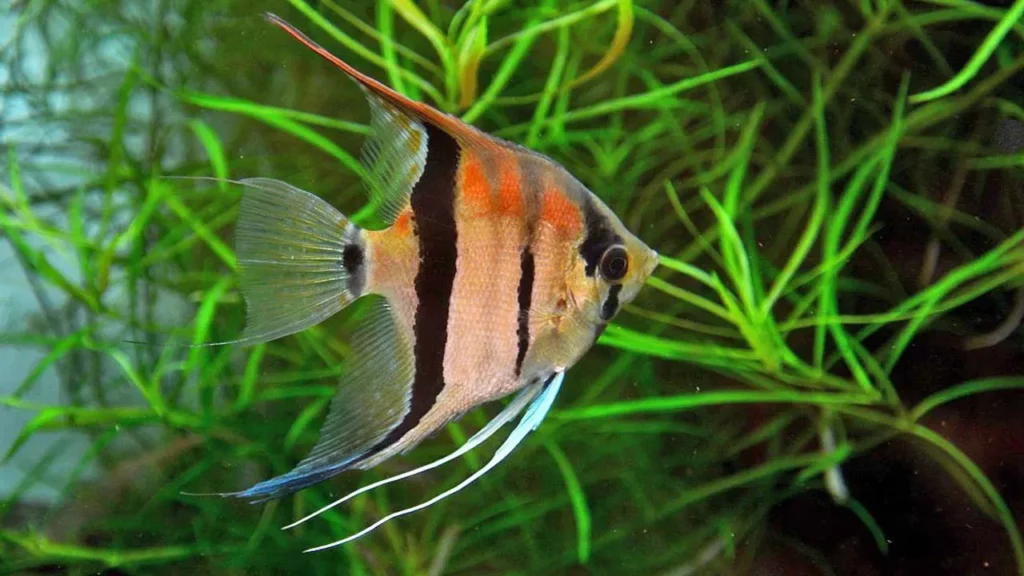
Age and maturity
Age:
- Juveniles: While young Angelfish might exhibit early signs of curiosity or even courtship behaviors, they’re typically not ready to breed. Most Angelfish start reaching sexual maturity around 6 to 12 months of age.
- Prime Breeding Age: Angelfish are usually in their prime breeding age between 12 to 36 months. During this period, they’re physically mature, robust, and have the highest likelihood of successful breeding.
- Older Angelfish: While older Angelfish can still breed, their fertility might decrease with age. After the age of 3 years, the frequency of spawning and the viability of eggs might reduce.
Maturity Indicators:
- Size: One of the most apparent indicators of maturity is size. While there can be variations based on genetics and diet, most Angelfish are ready to breed when they reach about 3 to 4 inches in body length, excluding their long fins.
- Physical Development: Mature Angelfish have a fuller, more rounded body compared to the slender profile of juveniles. Their fins are fully developed, and their colors are more vibrant.
- Behavioral Signs: Mature Angelfish often exhibit territorial behaviors, defending specific areas of the tank. They might also start pairing off, showing signs of courtship, and even cleaning surfaces in preparation for laying eggs.
Considerations:
- Health: Age and size are not the only factors to consider. The Angelfish should be in good health, free from diseases or parasites, and displaying active behaviors.
- Diet: A balanced, nutritious diet in the months leading up to breeding can enhance fertility and the overall health of both the parents and the offspring.
- Genetics: If you’re aiming for specific traits in the offspring, understanding the genetics of the breeding pair is essential. Some Angelfish might carry genes for particular colors or patterns that can be passed on to their fry.
Physical attributes to look for
Physical Attributes to Look For
Choosing the right partners for the delicate dance of breeding goes beyond just age and maturity. It’s about selecting individuals that not only carry the promise of healthy offspring but also the potential for unique traits and characteristics.
- Body Shape: A well-proportioned, symmetrical body is a good indicator of overall health and genetic quality. Look for Angelfish with a smooth, oval-shaped body without any deformities or irregularities.
- Fins: The fins should be full, long, and free from tears or ragged edges. They should extend gracefully without any clamping or drooping. The dorsal and anal fins, in particular, should be well-developed and symmetrical.
- Color and Patterns: While this is often a matter of personal preference, especially if you’re breeding for specific color morphs, vibrant and clear colors are generally indicative of good health and genetics. The patterns should be distinct, whether you’re looking at striped, marbled, or solid-colored Angelfish.
- Eyes: Bright, clear eyes without any cloudiness or swelling are a sign of a healthy Angelfish. They should be alert and responsive to their surroundings.
- Gill Movement: The gills should operate smoothly without any rapid or labored movements. This indicates that the fish is respiring comfortably and is free from gill-related diseases.
- Vent Identification: While this is a more subtle attribute, identifying the gender of Angelfish can be done by examining the vent. Males typically have a more pointed vent, while females have a rounder, broader one. This can be especially useful if you’re trying to ensure a balanced male-to-female ratio in your breeding setup.
- Absence of Diseases: Ensure that the Angelfish show no signs of diseases or parasites. This includes spots, unusual growths, lesions, or any erratic behavior.
- Activity Level: A potential breeding candidate should be active, swimming gracefully throughout the tank. Lethargy or hiding can be signs of stress or underlying health issues.
- Compatibility: While this isn’t a physical attribute per se, observing how potential breeding pairs interact can give insights into their compatibility. Look for pairs that spend time together, exhibit courtship behaviors, and don’t show signs of aggression towards each other.
Behavior indicators
- Pairing Off: One of the earliest signs of breeding readiness is when two Angelfish start spending more time together, swimming side by side and often mirroring each other’s movements. This pairing off indicates a bond forming, a precursor to potential breeding.
- Territorial Behavior: As breeding time approaches, Angelfish can become more territorial. You might notice them defending a particular area of the tank, chasing away other fish, and even engaging in mild skirmishes with each other. This behavior is a sign that they’re establishing a breeding site.
- Surface Cleaning: A fascinating behavior to watch for is when the Angelfish start cleaning a surface, be it a broad leaf, a flat rock, or even the aquarium glass. They’ll meticulously pick at the surface, removing any debris. This behavior is a strong indicator that they’re preparing a site for laying eggs.
- Courtship Displays: Angelfish engage in a series of courtship behaviors. This can include gentle nipping, flaring of fins, and a dance-like movement where they circle each other. These displays are both a sign of affection and a way to establish dominance between the pair.
- Decreased Appetite: As the actual spawning time approaches, it’s not uncommon for Angelfish to show a decreased interest in food. Their focus shifts primarily to breeding activities.
- Protectiveness: Once eggs are laid, both parents often exhibit protective behaviors. They’ll guard the eggs zealously, fanning them with their fins to ensure good oxygenation and chasing away any potential threats.
- Compatibility Signs: While occasional skirmishes can be normal, especially during the establishment of territories, it’s essential to ensure that the pair is genuinely compatible. Constant aggression, where one fish is always hiding or appears stressed, might indicate a mismatch. In such cases, it might be necessary to reconsider the pairing.
- Parental Care: Post-spawning, observe how the pair interacts with the eggs and, eventually, the fry. Good parents will tend to the eggs, remove any unfertilized or fungus-infected ones, and later, shepherd their fry around the tank. This behavior is a good indicator of their potential success in raising offspring.
Breeding Process
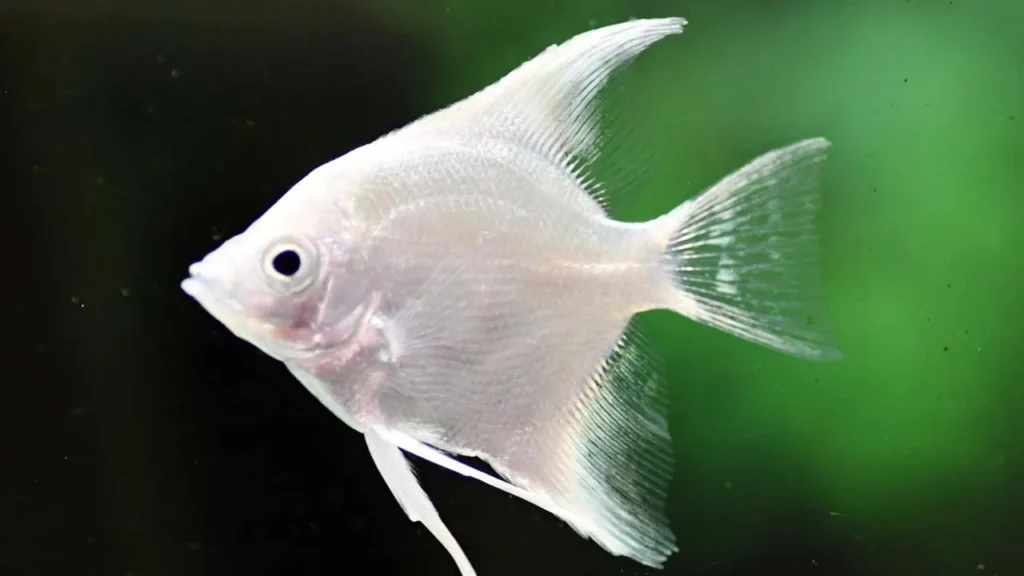
Courtship behavior
- Flaring and Display: One of the first signs of courtship is the flaring of fins. Angelfish will spread their fins wide, showcasing their full size and beauty. This display is both a sign of attraction and a way to establish dominance or territory.
- Lip Locking: It might sound like a passionate kiss, but in the world of Angelfish, lip locking is a test of strength. Two Angelfish will lock their mouths together, pushing and twisting in a show of might. While it can look aggressive, it’s a standard part of their courtship ritual, determining dominance between the pair.
- Circling Dance: This is where the ballet truly begins. The pair will swim in tight circles around each other, often with their bodies touching. This dance strengthens their bond and is a precursor to spawning.
- Nudging: The male will often nudge the female’s belly, signaling his interest and urging her to release her eggs. This gentle push is both a sign of affection and an essential part of the spawning process.
- Site Selection and Cleaning: As part of their courtship, the pair will often select a breeding site together. Once chosen, they engage in a joint cleaning effort, meticulously preparing the surface for the eggs. This shared task further strengthens their bond and ensures the chosen site is perfect for their offspring.
- Color Intensification: During courtship, it’s not uncommon for Angelfish to display intensified colors. This vibrancy makes them even more attractive to their partner and is a clear sign of their breeding readiness.
- Harmony and Compatibility: While courtship can involve tests of strength and occasional skirmishes, the overall interaction should be harmonious. Constant aggression or one partner always retreating might indicate a lack of compatibility.
Spawning
- Choosing the Site: Angelfish typically prefer broad, flat surfaces for laying their eggs. This could be a large leaf, a flat rock, a piece of slate, or even the aquarium glass. The site, which they would have meticulously cleaned during their courtship, provides a safe canvas for their offspring.
- Egg Laying: The female takes the lead during this phase. She’ll swim over the chosen site, laying a row of eggs. These eggs are adhesive and will stick to the surface. A healthy female can lay anywhere from a few hundred to over a thousand eggs during a single spawning event.
- Fertilization: Following closely behind the female, the male swims over the freshly laid eggs, releasing his milt. This process fertilizes the eggs. The male’s role is crucial, ensuring that the maximum number of eggs are fertilized and have the potential to develop into fry.
- Guarding the Brood: Once the eggs are laid and fertilized, the parents become fiercely protective. They’ll guard the site, chasing away any potential threats. This protective behavior is a testament to their parental instincts and the importance of the next generation.
- Egg Care: Beyond just guarding, Angelfish parents actively care for the eggs. They’ll fan the eggs with their fins, ensuring a steady flow of oxygenated water, which is vital for the development of the embryos. They’ll also pick off any unfertilized or fungus-infected eggs, keeping the brood healthy.
- Color of the Eggs: Healthy, fertilized eggs will typically have a translucent, amber hue. Unfertilized eggs, on the other hand, often turn white and may develop a fungal growth. The parents, with their keen instincts, will usually remove these to prevent the fungus from spreading.
Fertilization
The magic moment post-spawning, where life’s potential is truly unlocked, is during fertilization. This process, while seemingly simple, is a delicate interplay of timing, precision, and nature’s own design.
- The Role of Milt: Milt is the fluid containing sperm that the male Angelfish releases. As the female lays her eggs, the male follows closely behind, releasing his milt over them. This synchronized dance ensures that the eggs are immediately exposed to the sperm, maximizing the chances of successful fertilization.
- External Fertilization: Unlike many animals, fish, including Angelfish, typically undergo external fertilization. This means that the eggs are fertilized outside the female’s body. The advantage of this method is that a large number of eggs can be fertilized at once, increasing the chances of offspring survival.
- Immediate Changes: Once an egg is fertilized, cellular division begins almost immediately. The once single-celled egg starts its journey of transformation, dividing and evolving into a multi-cellular organism.
- Egg Transparency: A fascinating aspect of Angelfish eggs is their semi-transparency. This allows keen observers to actually witness the development inside. Over time, you can see the formation of tiny eyes and the gentle twitching of developing embryos.
- Protection from Parents: Post-fertilization, the parental instincts of Angelfish kick into high gear. They guard the fertilized eggs zealously, ensuring no threats come close. This protective behavior is crucial, as fertilized eggs are a delicacy for many aquatic creatures.
- Duration: Fertilized Angelfish eggs will typically hatch in about 60 to 72 hours, depending on the water temperature. During this period, the parents continue their vigilant watch, fanning the eggs and removing any that don’t develop to prevent fungal infections.
- Environmental Factors: Successful fertilization can be influenced by various factors, including water quality, temperature, and even the health of the parents. Ensuring optimal conditions can increase the chances of a higher number of eggs being fertilized.
Care of eggs
Once the dance of fertilization concludes, the spotlight shifts to the tiny, delicate orbs of life – the eggs. These fragile entities, bearing the promise of the next generation, require meticulous care, both from their parents and from the aquarist. Let’s explore the intricacies of caring for Angelfish eggs.
- Parental Vigilance: Nature has endowed Angelfish with strong parental instincts. Post-spawning and fertilization, the parents stand guard over their clutch of eggs. They chase away potential threats, ensuring the safety of their future offspring.
- Fanning the Eggs: One of the most crucial roles the parents play is fanning the eggs with their fins. This action ensures a continuous flow of oxygenated water over the eggs, which is vital for the embryos’ development. It also helps prevent the growth of mold or fungus on the eggs.
- Removing Unviable Eggs: Not all eggs will develop. Some might not be fertilized, while others might become infected with fungus. The parents, with their keen instincts, will pick off and remove these unviable eggs. This action prevents the spread of fungus to healthy eggs.
- Aquarist’s Role:
- Water Quality: Maintaining pristine water quality is paramount. Ensure the water is clean, with stable parameters. Regularly check the ammonia, nitrite, and nitrate levels. Any spike in these can be detrimental to the eggs.
- Temperature: A stable temperature, typically between 76°F to 80°F (24°C to 27°C), is ideal for Angelfish egg development.
- Lighting: While Angelfish eggs don’t require complete darkness, it’s a good idea to provide a subdued lighting environment. This mimics their natural habitat and reduces stress on the guarding parents.
- Isolation: If you find that other tank inhabitants pose a threat to the eggs, or if the parents themselves seem stressed, consider moving the eggs to a separate breeding tank. This ensures a controlled environment for the eggs to develop.
- Potential Challenges:
- First-time Parents: It’s not uncommon for first-time Angelfish parents to be a bit clumsy. They might eat their eggs or not care for them adequately. Don’t be disheartened. With subsequent spawns, they usually become better parents.
- Fungal Infections: Despite the best efforts, some eggs might develop a white, cottony fungus. If the parents aren’t removing them, you can gently do so using a turkey baster to prevent the fungus from spreading.
Raising Angelfish Fry
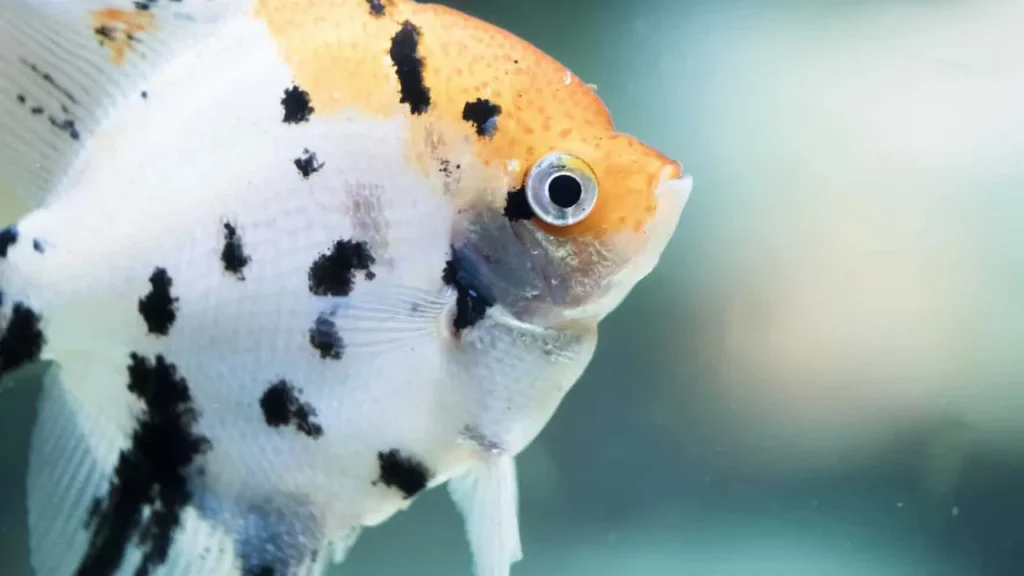
Initial care and feeding
The hatching of Angelfish eggs marks the beginning of a new chapter. These tiny, wriggling fry, while seemingly fragile, are bursting with life and potential. However, this initial stage of their life is crucial and requires attentive care, especially when it comes to their nutrition.
- First Moments: Post-hatching, Angelfish fry are not immediately free-swimming. They remain attached to the hatching site, absorbing nutrition from their yolk sacs. During this period, which lasts about 5-7 days, they don’t require external feeding.
- Parental Care: Even in these early stages, Angelfish parents continue their protective role. They might move the fry to different locations within the tank, ensuring their safety. It’s fascinating to watch as they gently pick up the fry in their mouths and transport them.
- First Foods:
- Infusoria: These are microscopic organisms that thrive in aquatic environments. Being tiny, they are perfect for the minuscule mouths of Angelfish fry. You can cultivate infusoria at home or purchase them from specialized suppliers.
- Liquid Fry Food: Available commercially, these are specially formulated to cater to the nutritional needs of newborn fry.
- Newly Hatched Brine Shrimp: As the fry grow a bit larger, usually after the first week, they can start consuming newly hatched brine shrimp. These offer excellent nutrition and help boost growth.
- Feeding Frequency: At this tender age, Angelfish fry have a high metabolic rate. It’s recommended to feed them multiple times a day, ideally 3-5 times, ensuring they receive continuous nutrition.
- Water Quality: Clean water is paramount for the health and growth of the fry. Regular water changes, using a gentle siphon to avoid disturbing the fry, can help maintain pristine water conditions. However, ensure the new water matches the temperature and pH of the existing tank water.
- Protection from Predators: If the aquarium houses other fish, it’s essential to ensure the fry are protected. This might involve moving them to a separate rearing tank or using a mesh divider to keep potential predators at bay.
- Monitoring Growth: Keep a keen eye on the fry’s development. Healthy fry should grow steadily, becoming more active and free-swimming with each passing day.
Growth stages and milestones
The journey from a tiny, wriggling fry to a majestic, graceful Angelfish is a marvel of nature. As they grow, these aquatic wonders go through various stages, each with its unique characteristics and milestones.
- Yolk Sac Fry: This is the stage immediately after hatching. The fry are still attached to their hatching site, drawing nutrition from their yolk sacs. They’re not free-swimming and remain relatively stationary. This stage lasts for about 5-7 days.
- Free-swimming Fry: Once the yolk sac is absorbed, the fry become more active and start swimming around. This is a critical milestone, marking their transition to external feeding. At this stage, they’re ready to consume infusoria, liquid fry food, and eventually, newly hatched brine shrimp.
- Juvenile Stage: Around the 4-week mark, the fry begin to resemble miniature versions of adult Angelfish. Their body shape starts to take form, and they become more agile swimmers. They can now consume larger foods, like micro-worms and finely crushed flake food.
- Sub-adult Stage: By 2-3 months, the Angelfish have grown significantly and developed more distinct features. Their fins are more pronounced, and initial color patterns begin to emerge. They can now eat regular-sized flake food, small pellets, and larger live foods.
- Sexual Maturity: Around the 6-12 month mark, depending on genetics and environmental factors, Angelfish reach sexual maturity. They start exhibiting breeding behaviors, and physical differences between males and females become more evident.
- Full Adulthood: By the time they’re 12-18 months old, Angelfish are considered fully grown adults. They showcase their full colors, patterns, and finnage, embodying the beauty and grace that make them so beloved among aquarists.
Key Considerations:
- Dietary Needs: As Angelfish progress through these stages, their dietary needs evolve. It’s crucial to offer appropriate food sizes and types at each stage to ensure optimal growth and health.
- Water Quality: Clean, stable water conditions are vital throughout their growth. Regular water changes, monitoring of water parameters, and a well-maintained filtration system can support their development.
- Space: As the Angelfish grow, they’ll require more space to swim and thrive. Ensure your aquarium can accommodate their increasing size, or be prepared to transition them to a larger tank.
- Social Interactions: Angelfish are social creatures. Observing their interactions, especially as they approach sexual maturity, can provide insights into their health, hierarchy, and potential breeding pairs.
Transitioning to adult food
As Angelfish fry grow and evolve, so do their dietary needs. The transition from fry-specific foods to adult foods is a pivotal phase, ensuring they receive the right nutrients for continued growth and health.
- Recognizing the Right Time: The first step is to identify when your Angelfish are ready for this transition. Typically, when they reach about an inch in size and have a more defined body shape resembling adult Angelfish, they’re ready to start the transition.
- Gradual Introduction: Instead of an abrupt switch, it’s best to introduce adult foods gradually. Start by offering finely crushed flake food or smaller-sized pellets alongside their regular fry food. This allows them to get accustomed to the taste and texture.
- Variety is Key: Adult Angelfish thrive on a varied diet. Introduce a mix of high-quality flake food, pellets, live foods (like brine shrimp and bloodworms), and even some vegetable matter. This ensures they receive a balanced diet, rich in essential nutrients.
- Monitor Consumption: Keep a close eye on how the Angelfish respond to the new foods. They should actively consume the food, and there shouldn’t be much leftover. Adjust the quantity based on their consumption to prevent overfeeding.
- Frequency: While fry require multiple feedings throughout the day, as they transition to adult food, you can reduce the feeding frequency. Typically, feeding them 2-3 times a day is sufficient.
- Supplements: Consider adding vitamin and mineral supplements to their diet. These can be mixed with their food and help in ensuring they get all the necessary nutrients, especially during this growth phase.
- Avoid Overfeeding: As you introduce richer, adult foods, be cautious about overfeeding. Overfeeding can lead to obesity and other health issues and can also pollute the tank water.
- Observing Health: As you transition their diet, regularly observe the Angelfish for signs of good health. They should be active, display vibrant colors, and show steady growth. If you notice any lethargy or signs of digestive issues, you might need to adjust their diet.
- Consultation: If in doubt, don’t hesitate to consult with fellow aquarists or experts. They can provide insights based on their experiences and might offer recommendations on specific brands or foods that work well for Angelfish.
Frequently Asked Questions – FAQ
Give Us Feedback
Please help us get better by making suggestions or giving feedback, we really do listen to it!
